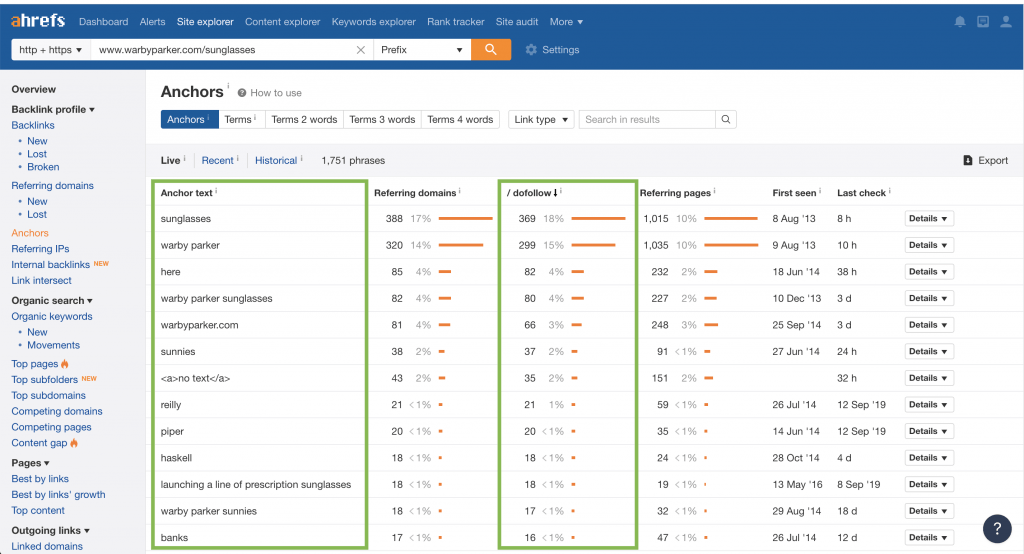Writing good Anchor Text is vital to any digital marketing or Search Engine Optimization (SEO) strategy.
There are some essentials, and some rules of thumb, worth remembering.
Here they are:
Anchor Text Defined
You’ve seen plenty of text looking like this.
It’s a hyperlink (i.e. clickable text) that, when clicked, takes the visitor to a different page on the web.
The “You’ve seen plenty of text looking like this” … is the anchor text. The destination URL hides behind the anchor text.
The content creator can design the anchor text to reveal or conceal, as they see fit.
Different Types of Anchor Text
There are 5 different types of anchor text (and one anchor type that isn’t text at all).
URL anchors
URL anchors (also known as Naked URLs or Naked links) are precisely what the name implies.
There is no attempt to conceal the URL from the reader. You can manually copy/paste the displayed link text into a new browser tab, or even manually type it. Result? The correct page will open.
Example: http://www.thehoth.com
In the HTML code, the anchor text appears between the <a> tags:
<a href=”https://www.thehoth.com”>The HOTH</a>
Generic anchor text
Generic anchor text does make some attempt to conceal the URL, with an obvious or marginally less basic call-to-action.
Example: Clink this link
This link takes you to exactly the same page as the URL anchor example shown above.
Branded anchor text
Branded anchor text conceals the URL with something that tells the reader about you (or your brand).
Because the resulting page will do exactly that. It won’t necessarily be about the reader, or address the reader’s objectives. It won’t overtly be a sales page or optin page.
Example: The HOTH
This achieves the same result as the Generic and Branded anchor hyperlinks did above.
They are ideal when:
- The link takes the reader to a video
- When you want to break up text-heavy content to give it visual texture
Same link again, but now you know ahead of time that if you click the link, you’re probably going to The HOTH’s homepage.
Exact-match anchor text
Exact-match anchor text takes the reader to a page that is about the precise keyword string used in the anchor.
If a link displaying “The HOTH’s anchor text expertise” takes you to a page titled “The HOTH’s anchor text expertise” …
… which talks about precisely that …
… it’s Exact-match anchor text.
Partial-match anchor text
If, conversely, the clickable text is:
“The HOTH’s anchor expertise”, “The HOTH’s anchor text knowledge”, or some subtle variation on the title and content of the linked page …
… it’s Partial-match anchor text.
(This is also sometimes referred to as Phrase-match anchor text.)
Image Anchors
Image anchors are completely non-textual.
The anchor is an image, but you click on it as you would a text hyperlink. Try this one:
This achieves the same result as the Generic and Branded anchor hyperlinks did above.
They are ideal when:
- The link takes the reader to a video
- When you want to break up text-heavy content to give it visual texture
The History of Anchor Text and Search Engine Rankings
Since 1998, content marketing has been a battleground between System Builders and SEO Strategy Specialists.
Both want to help searchers end their search. However, the system builders (e.g. Google) don’t care which link on a SERPS page ends the search. They just want to see non-spammy, high-quality, high-relevancy, natural-language content webpages that are easy to index.
SEO strategy specialists do care.
They aren’t averse to high-quality webpages … as long as the search ends on their site.
Initially, the game was almost simple: Use anchor text stuffed as much as possible with target keywords. Build lots of backlinks stuffed with the same. Mix the anchor types to attain an optimal anchor text metric.
Then in 2012, Google’s Penguin update changed everything.
Google started to incentivize user experience and punish over-optimization. Sites stuffed with manipulative anchor text went from SERPS page 1 to unranked overnight. Entire businesses went bust.
Subsequent algorithm updates have made the job harder still.
Anchor Text/Link Building Strategies
There are essentially three anchor text/backlink strategies.
SEO-oriented
With this strategy, search engine rankings are the objective. Get your page top-ranked on page 1 of the SERPS. Period.
The assumptions with this strategy (and they are not invalid) are:
- The top-ranked link gets the lion’s share of clicks
- If your page SEO doesn’t land you on page 1 at all, you will get near-zero traffic
It demands lots of:
- Link building (internal links, external links, backlinks)
- Targeting long-tail keywords
- Mixing the anchor types to get the optimal link anchor text metric
The risk with this strategy?
The optimal anchor text ratio is imaginary.
No one knows what it is. It is constantly changing anyway.
Brand name or Story oriented
This strategy is simpler: Ignore SEO.
Just make your content rich with brand anchor keywords, or keywords supporting the story you want to tell.
The risk with this strategy?
You might not rank well for anything, meaning you have to acquire traffic through social media or pay-per-click.
Search Experience Optimization (SXO) oriented
This strategy doesn’t ignore SEO, but neither does it make it the objective.
Essentially, this strategy is, Give users (and Google) what they want. Help users end their search by giving them a positive experience. Accept that you won’t necessarily rank well initially, but your page’s ranking factors will improve over time.
The strategy we recommend
We recommend a mix of SEO and SXO.
Have a diversity of anchor types, with your users in mind.
Include lots of Image, Naked, and Natural anchor text, so that your exact-match-keyword-rich anchors stand out. Think about the anchor text ratio (we have a post on that here), but don’t obsess about it.
Have your webmaster regularly check the health of your backlinks in ahrefs.com. (You can enter the page you need to check, then go to Inbound Links>Anchors.)

Conclusion
Writing good anchor text is as important as it’s ever been. But now it’s as important to have a clear anchor text/backlink strategy, thereby keeping Google’s algorithm happy. This requires a diversity of anchor text types, and a focus on positive user experience.





